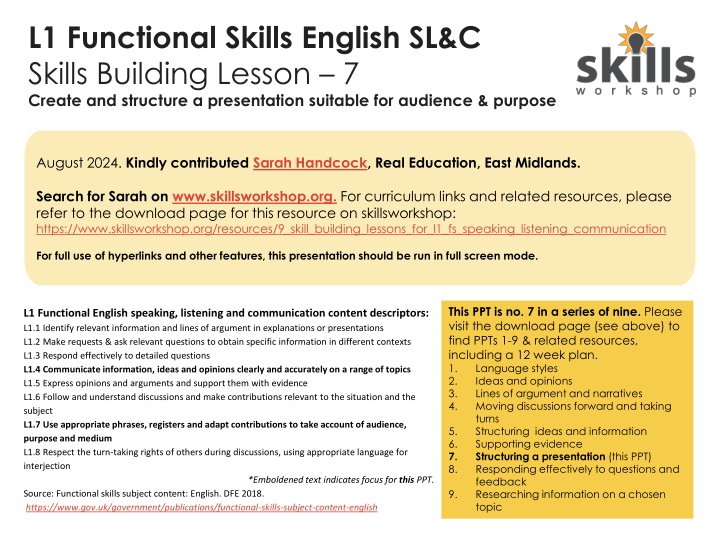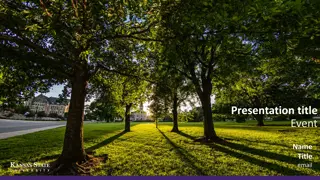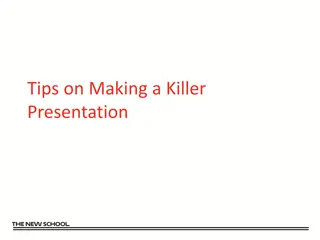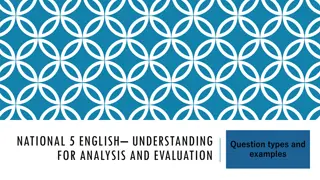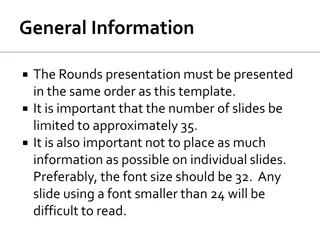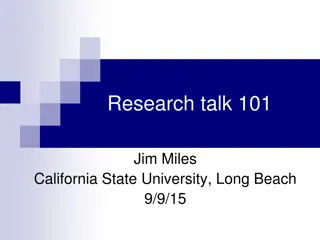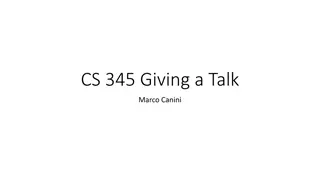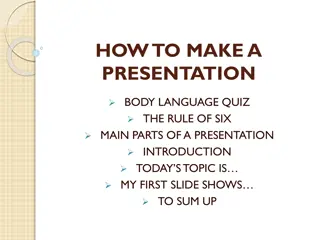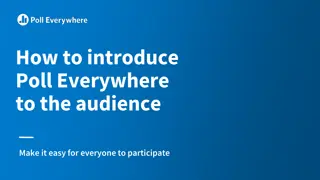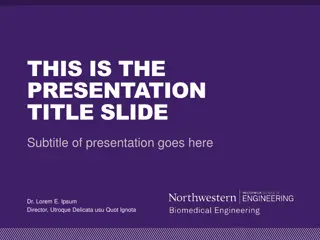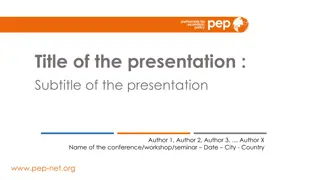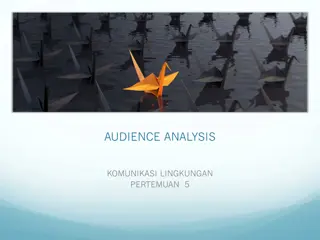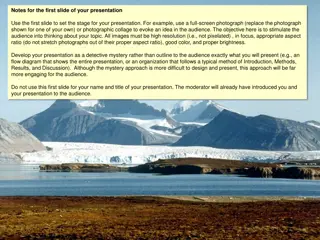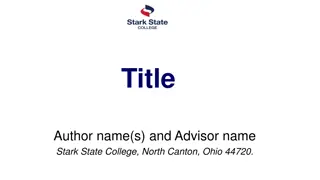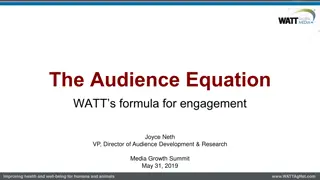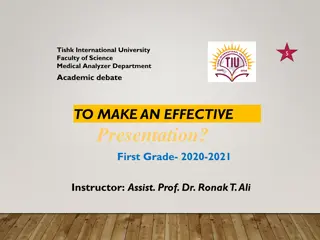Structuring a Presentation for Audience Impact
In this lesson, you will learn how to effectively structure a presentation for maximum impact on your audience. Discover key vocabulary, techniques, and strategies to captivate your listeners and deliver a compelling message. Enhance your public speaking skills and be prepared to engage with your audience through a structured presentation format.
Download Presentation

Please find below an Image/Link to download the presentation.
The content on the website is provided AS IS for your information and personal use only. It may not be sold, licensed, or shared on other websites without obtaining consent from the author.If you encounter any issues during the download, it is possible that the publisher has removed the file from their server.
You are allowed to download the files provided on this website for personal or commercial use, subject to the condition that they are used lawfully. All files are the property of their respective owners.
The content on the website is provided AS IS for your information and personal use only. It may not be sold, licensed, or shared on other websites without obtaining consent from the author.
E N D
Presentation Transcript
L1 Functional Skills English SL&C Skills Building Lesson 7 Create and structure a presentation suitable for audience & purpose Description: swlogo August 2024. Kindly contributed Sarah Handcock, Real Education, East Midlands. Search for Sarah on www.skillsworkshop.org. For curriculum links and related resources, please refer to the download page for this resource on skillsworkshop: https://www.skillsworkshop.org/resources/9_skill_building_lessons_for_l1_fs_speaking_listening_communication For full use of hyperlinks and other features, this presentation should be run in full screen mode. This PPT is no. 7 in a series of nine. Please visit the download page (see above) to find PPTs 1-9 & related resources, including a 12 week plan. 1. Language styles 2. Ideas and opinions 3. Lines of argument and narratives 4. Moving discussions forward and taking turns 5. Structuring ideas and information 6. Supporting evidence 7. Structuring a presentation (this PPT) 8. Responding effectively to questions and feedback 9. Researching information on a chosen topic L1 Functional English speaking, listening and communication content descriptors: L1.1 Identify relevant information and lines of argument in explanations or presentations L1.2 Make requests & ask relevant questions to obtain specific information in different contexts L1.3 Respond effectively to detailed questions L1.4 Communicate information, ideas and opinions clearly and accurately on a range of topics L1.5 Express opinions and arguments and support them with evidence L1.6 Follow and understand discussions and make contributions relevant to the situation and the subject L1.7 Use appropriate phrases, registers and adapt contributions to take account of audience, purpose and medium L1.8 Respect the turn-taking rights of others during discussions, using appropriate language for interjection *Emboldened text indicates focus for this PPT. Source: Functional skills subject content: English. DFE 2018. https://www.gov.uk/government/publications/functional-skills-subject-content-english
Functional Skills Level 1 Speaking and Listening Learning Objective: to know how to create and structure a presentation suitable for the audience and purpose Last lesson recap: What do you need to add to your opinions to make them more convincing when you speak?
Key Vocabulary Check you understand: introduction main body conclusion summary visuals audience purpose anecdote eye contact preparation narrative
At the end of this unit, you will have to give a 3- 4 minute presentation. You will be able to pick the topic you want to present on. After you have spoken about your topic, you will have to answer questions from your audience for 3- 4 minutes.
In todays lesson, we are going to look at how to create a presentation and how you can organise your ideas. ***Link back to last lesson: last lesson, we focussed on developing our ability to support our ideas with evidence and you should have created a short speech to explain why your chosen sports star was dedicated. Today, we are going to develop this, by exploring how you can improve your speech with the presentation techniques you will learn about.
What makes a presentation effective? An effective presentation keeps you hooked the whole time, no matter whether you watch it online or in person. There are multiple examples of effective presentations that people have enjoyed listening to. For example, the introduction of the iPhone by Steve Jobs remains one of the most influential speeches. Watch the clip of his speech: Steve Jobs' iphone Introduction Speech 2007 Who was his audience? What was his purpose? Why was his speech so effective? What techniques did he use to engage his audience?
Where to start? Firstly, you need to pick a suitable topic. It is best to pick something that interests you, or you have knowledge about, as this will make it easier to speak about naturally and create more interest in it. If it doesn t interest you, it won t interest your audience! Secondly, do you remember how we discussed audience and purpose in lesson 2? You need to consider who your audience will be and what the purpose of your presentation is: Example: If you are going to deliver a talk to your teacher and classmates about your favourite football team, your purpose is to inform them about the team, so you need to include the right information. Secondly, you need to make sure you use language appropriate to your audience who are people that may not be football supporters. This means you will need to explain any football terminology they may not understand.
Audience and Purpose Watch the short examples of presentations below. For each one, identify: 1. The audience 2. The purpose 3. Decide whether or not you think it was an effective speech How to instantly freeze water How To INSTANTLY Freeze Water On Impact! . YouTube. Packer Anderson, 2022. How to train your cat to stop biting How to Train Your Cat Not to Bite . YouTube. Howcast, 2013. Dragon's Den Pitch BEST PITCH YET HAS DRAGONS BLOWN AWAY! | Dragons Den . YouTube. Shark, 2000. Discuss your thoughts about each presentation and decide how effective you think they are and why.
Once you have decided on the topic of your presentation and you know who your audience will be and what your purpose is, you need to think about how you are going to put your ideas together. The 5 tips on the next five slides are strategies you can use to help put together your ideas
#1 Well-defined structure Watch the video which explains how to create a good structure for your presentation. How to Structure a Presentation How to structure a presentation . YouTube. Prezi, 2023. The Key Points to Remember: The four key stages of designing a layout for a presentation are: 1. Preparation 2. Introduction 3. Main body 4. Conclusion The introduction of your presentation is your first chance to make a good impression on your audience. So, it's important to make it engaging and relevant to your topic. Your main body should have a clear and logical flow that builds on each point you make. And finally, your conclusion should summarize the main points of your presentation and leave a lasting impression on your audience, inspiring them to take action.
#2 Simplicity An effective presentation is simple and to the point. Just because you make a grand presentation with many facts and figures and thought-out details doesn t make it more effective. What s important is that your presentation hits the right points and leaves the audience impressed. When speaking, always focus on your main points and avoid drifting away to other topics or irrelevant details. It s best not to spend too much time explaining complex theories or terminologies. If you must, give brief summaries of the concepts your audience might not be familiar with, but spend the majority of your presentation focused on the information your audience will have an easier time understanding.
#3 Visuals Visuals enrich your presentation, help reinforce your words, highlight important points, and keep your audience engaged. Visuals are powerful tools. Most people are visual learners 65% to be exact. Therefore, visuals play an important role in understanding a topic. By incorporating visuals into your presentation, your audience will have an easier time digesting the information. To include visuals, you could create a PowerPoint to use, or you could have picture boards, handouts or a flip board.
#4 Connection with the Audience One way to achieve a connection with your audience is by sharing a personal story at the beginning of your presentation. Share something you ve struggled with or a common problem your audience members can relate to, or tell a fascinating story that reveals your values and experiences. An anecdote your audience will find amusing would also work, just as long as it relates to your topic. Storytelling is a powerful way to connect with your audience from the get-go, so think about incorporating a story element into your presentation to generate this connection. Making eye contact with your audience members when presenting is key. If you re presenting to a small group of people, it s easy, but if you re presenting to a wider audience, choose a couple of people to make eye contact with.
#5 Preparation Being prepared is the key to presentation success. If you practice something long enough, you ll be able to master it. Therefore, preparation is one of the most important aspects of an effective presentation. It s what truly makes an effective presentation and empowers you to be the best speaker you can be. When practising your presentation, you could: Create a mind map to help you memorize the key points or flash cards of summarised information. Plan out how you re going to start and end your presentation. Think about which statement or statistic you want to share to start your presentation speech. Decide what s going to be the last statement or question of your speech.
Plenary Have you achieved the learning objective? To know how to create and structure a presentation suitable to the audience and purpose. Go back to the speech on your chosen sports star which you created last lesson. Considering everything you have learned today - how could you improve it? 1. Could you change the structure or add an introduction or conclusion if you did not? 2. Could you add more persuasive language or supporting evidence if your goal was to convince your audience your sports star was dedicated? 3. If you wrote out a few brief notes could you make it into a PowerPoint and add some visuals? 4. Could you add in some stories or anecdotes to make it more interesting and relatable to your audience and include humour to engage them? Spend the remaining time you have left working on 1 way to improve your speech into a presentation using one of the techniques you have learned in today s lesson. ***Extension apply as many of the techniques as possible to make your speech into an engaging presentation.***
